11 Delicious Blueberry Varieties With Lorraine Summer From Trehane Nursery


Ed is a horticultural therapist, professional gardener and writer. Ed has a BSc in Occupational Therapy from Coventry University and a Diploma in Social and Therapeutic Horticulture (DipSTH) via Thive, the RHS and Pershore College. Ed runs a community kitchen garden in West Sussex, where he leads horticultural therapy sessions.
Reviewed By COLIN SKELLY

Colin is a Horticulturist and Horticultural Consultant with experience in a range of practical and managerial roles across heritage, commercial and public horticulture. He holds the Royal Horticultural Society’s Master of Horticulture award and has a particular interest in horticultural ecology and naturalistic planting for habitat and climate resilience.
Contributions From LORRAINE SUMMERS

Lorraine has worked with camellia plants for over 40 years. Based in Wimborne (Dorset), the nursery has various camellia species, cultivars and hybrids for sale and has links to the International Camellia Society.
IN THIS GUIDE
BLUEBERRY GUIDES
Container Growing
Cuttings Propagation
Feeding
Harvesting
Pruning
Repotting
Varieties
Winter Care
Blueberries are botanically named Vaccinium corymbosum and are part of the Ericaceae family.
Native to North America, blueberry shrubs produce delicious fruits and beautiful autumnal foliage and can grow well here in the UK’s climate.1The history of blueberries: From Native American staple to domesticated superfood. (2019, January 19). University of Illinois. Retrieved March 13, 2023, from https://extension.illinois.edu/blogs/garden-scoop/2019-01-19-history-blueberries-native-american-staple-domesticated-superfood
“I like ‘Berkeley’ as its berries are very sweet,” shares Lorraine Summer, owner of Trehane Nursery, which specialises in blueberry plants.
“‘Chandler’ and ‘Herbert’ also have a very good flavour and are favourites of mine.”
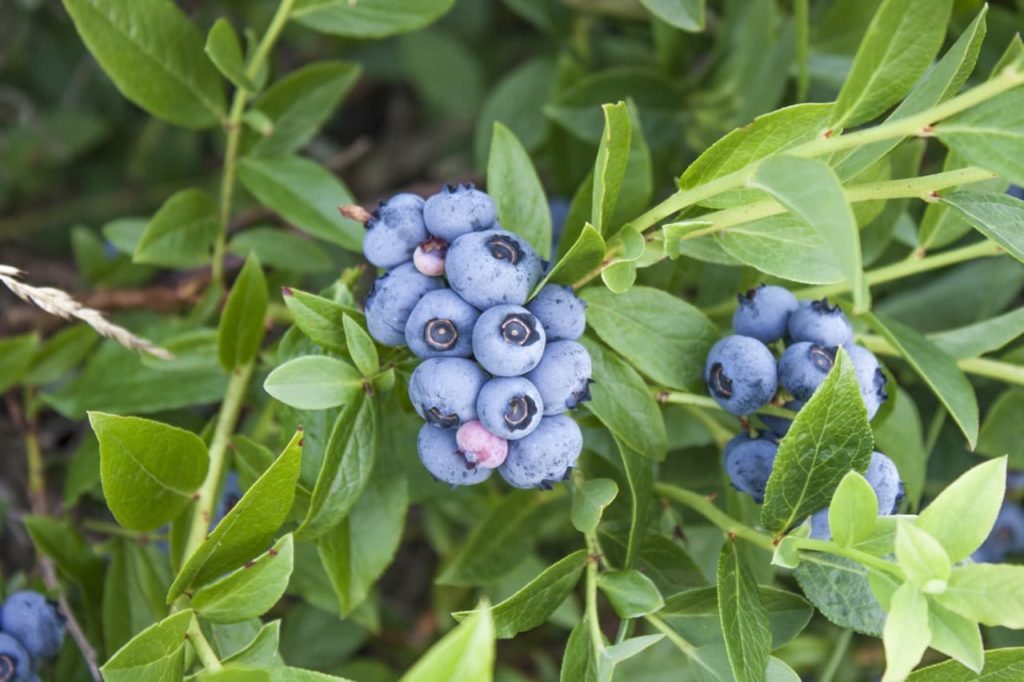
What follows are eleven popular types of blueberries which can be grown in the UK, including some very special RHS AGM recipients.
“There are Blueberry cultivars more suitable for smaller gardens that grow 0.5m-1m high & wide,” shares Master Horticulturist Colin Skelly.
I grow a couple of these in my garden, including V. ‘Sunshine Blue’ and V. ‘Top Hat’, and these produce a large crop on relatively small bushes.
“The taste of home grown blueberries picked straight from the bush is a real summer highlight in the garden.”
All of the varieties mentioned below must be grown in acidic, loam or sandy soil in full sun or part-shade in a sheltered location.
Also, they all bear fruit in the summer and are H6 hardy unless otherwise mentioned, meaning they can be grown in any and all areas of the UK throughout the year.
1) V. corymbosum ‘Duke’

- COMMON NAME(S): blueberry ‘Duke’
- FOLIAGE: Green, red and yellow
- FLOWERS: White
- FLOWERING SEASON(S): Spring / Summer
- FRUIT: Black and blue
- TYPICAL SIZE: 1.5-2.5m in height, 1-1.5m spread
Perhaps one of the most readily available blueberries, ‘Duke’ is one of the larger cultivars that can grow to an eventual height of up to 2.5m.
Producing good size berries with a sweet flavour, it is no wonder it is so commonly grown not only domestically, but commercially as well.
Flowering later than others, but often ripening early, it can be an excellent choice for growing in areas where late frosts can present a problem.
Rated H6 for hardiness, blueberry ‘Duke’ can tolerate the worst of winters and temperatures as low as -15-20°C.
2) V. corymbosum ‘Spartan’
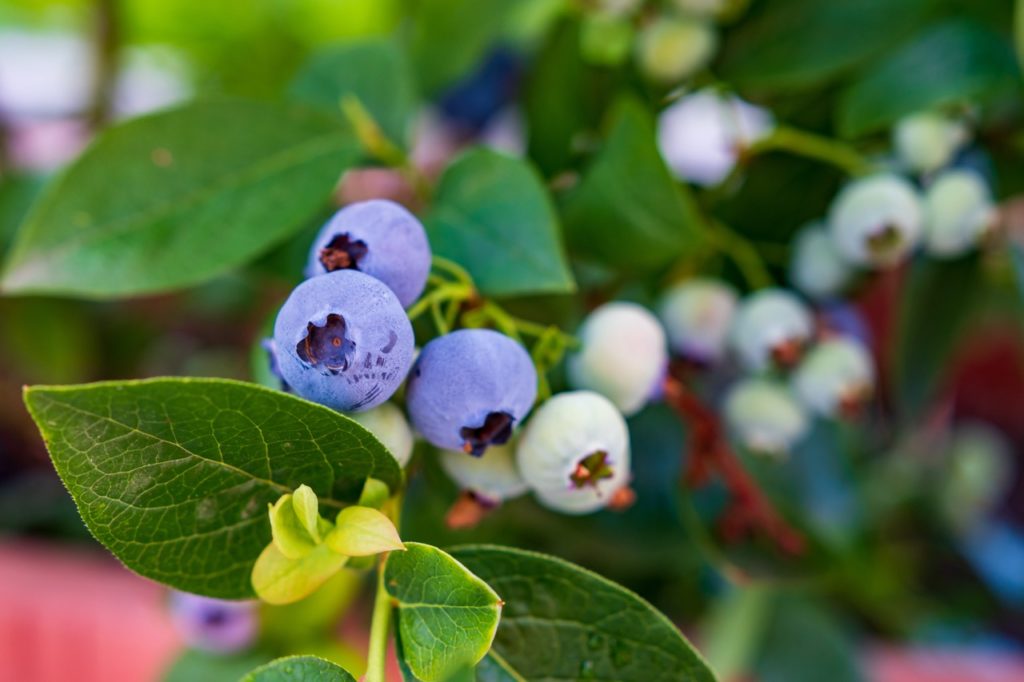
- COMMON NAME(S): blueberry ‘Spartan’
- FOLIAGE: Green, red and yellow
- FLOWERS: White
- FLOWERING SEASON(S): Summer
- FRUIT: Black and blue
- TYPICAL SIZE: 1-1.5m in height, 1-1.5m spread
Blueberry ‘Spartan’ is another popular variety which, unlike its name suggests, produces good crops.
Slightly smaller than ’Duke’, blueberry ‘Spartan’ will reach 1.5m in height and spread over time with an upright and bushy habit.
Fruiting from July, it is a vigorous shrub that produces deep blue-coloured berries with a good flavour.
Having received the RHS Award of Garden Merit (AGM), it has proven to perform reliably well.
3) V. ‘Berkeley’

- COMMON NAME(S): blueberry ‘Berkeley’
- FOLIAGE: Green, red and yellow
- FLOWERS: White
- FLOWERING SEASON(S): Spring
- FRUIT: Blue
- TYPICAL SIZE: 0.5-1m in height, 0.5-1m spread
With its spreading habit and large fruits, blueberry ‘Berkeley’ is a later fruiting shrub which is ready for harvesting in late July.
With vigorous growth, it can reach a little over 1m in height and spread over time and, as with all blueberries, requires an ericaceous soil.
Blueberry ‘Berkeley’ ripens to lighter blue, yet do not let this put you off as it is often recommended for its sweet and firm berries that are easy to pick.
4) V. ‘Chandler’
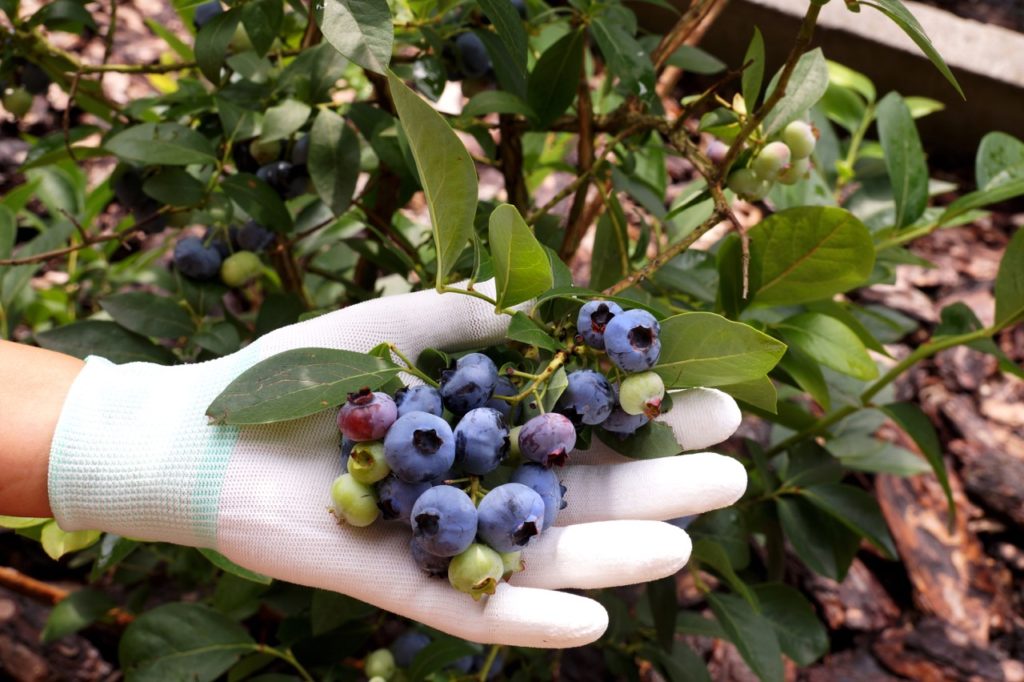
- COMMON NAME(S): blueberry ‘Chandler’
- FOLIAGE: Green, red and yellow
- FLOWERS: White
- FLOWERING SEASON(S): Summer
- FRUIT: Black and blue
- TYPICAL SIZE: 1-1.5m in height, 1-1.5m spread
For the biggest fruits, blueberry ‘Chandler’ is certainly worth considering as it can produce delicious berries up to 2cm.
A mid to late-season blueberry, ‘Chandler’ ripens slowly throughout the picking season and has lovely autumnal foliage.
With a bushy habit, this blueberry shrub can grow up to 1.5m tall and wide if given the right conditions.
5) V. corymbosum ‘Patriot’
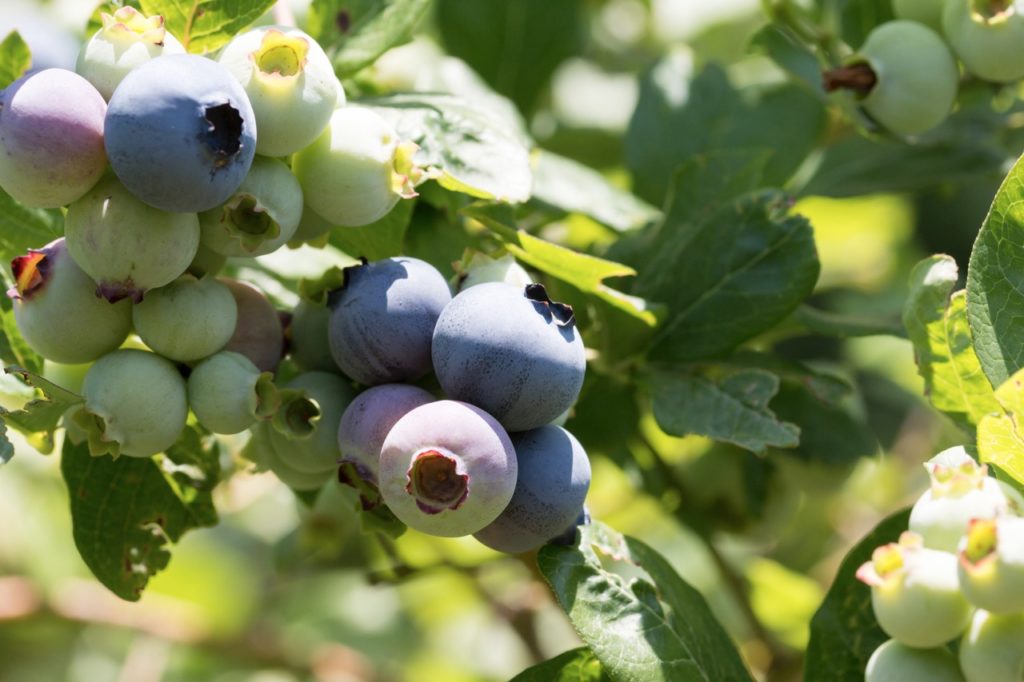
- COMMON NAME(S): blueberry ‘Patriot’
- FOLIAGE: Green and red
- FLOWERS: White and cream
- FLOWERING SEASON(S): Spring / Summer
- FRUIT: Black and blue
- TYPICAL SIZE: 1.5-2.5m in height, 1-1.5m spread
One of the larger blueberry shrubs, ‘Patriot’ can grow to a final size of 2.5m tall as it matures.
Fruiting in July, ‘Patriot’ is an early-season blueberry that produces mid-blue coloured and medium-sweet berries with an excellent flavour.
More tolerable of soil conditions than others, it can be a good choice for those growing on less-than-ideal ground conditions.
6) V. ‘Sunshine Blue’
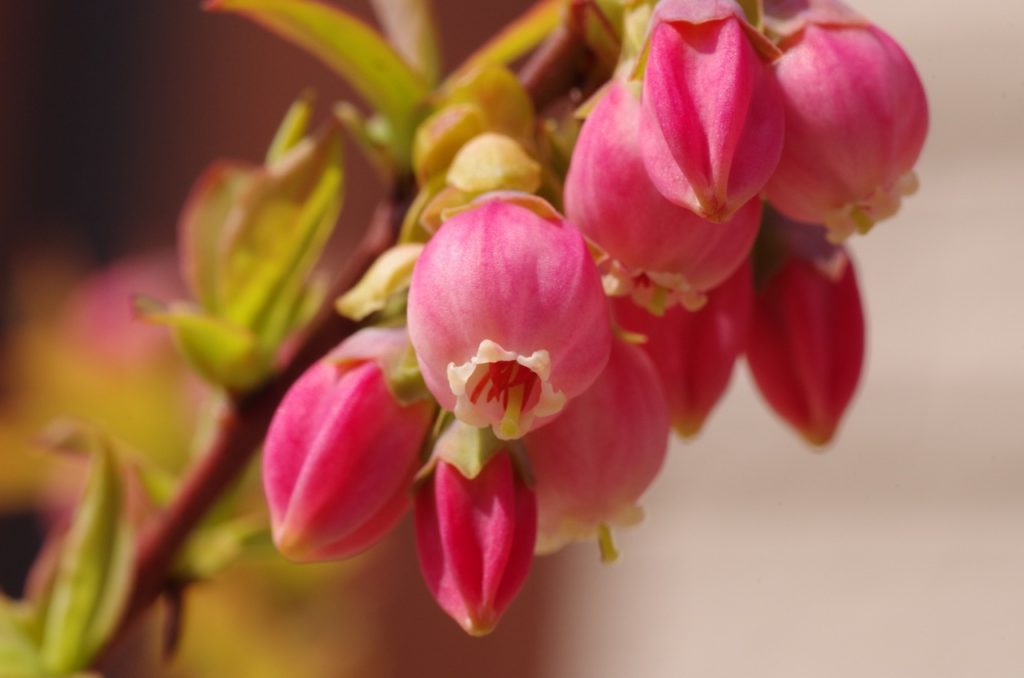
- COMMON NAME(S): blueberry ‘Sunshine Blue’
- FOLIAGE: Green, red and purple
- FLOWERS: White and pink
- FLOWERING SEASON(S): Spring
- FRUIT: Blue
- TYPICAL SIZE: 0.5-1m in height, 0.5-1m spread
If growing space is limited, then a smaller and more compact blueberry shrub such as ‘Sunshine Blue’ may be more suitable.
Blueberry ‘Sunshine Blue’ will have an eventual size of only 1m high and half as wide, making it ideal for growing in smaller spaces or containers.
A semi-evergreen blueberry shrub, it displays bright pink flowers before fruiting and its foliage provides lovely autumnal interest as the leaves turn purple-red.
7) V. ‘Pink Lemonade’
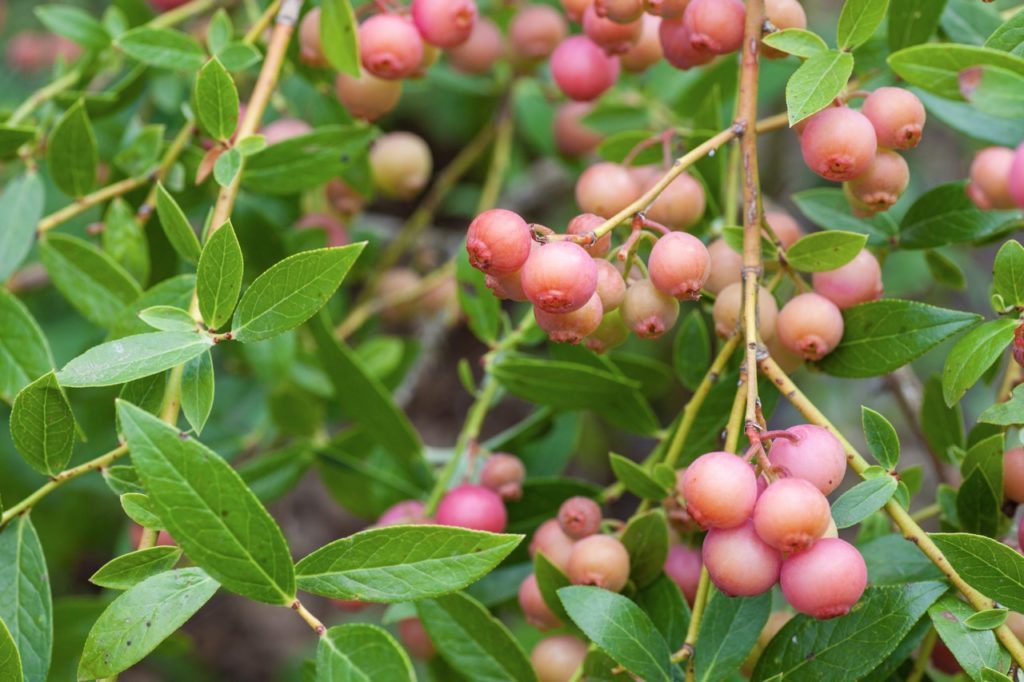
- COMMON NAME(S): blueberry ‘Pink Lemonade’
- FOLIAGE: Green, red and yellow
- FLOWERS: Pink
- FLOWERING SEASON(S): Spring
- FRUIT: Pink
- TYPICAL SIZE: 1-1.5m in height, 1-1.5m spread
For something totally different, this deciduous blueberry shrub produces blueberries, that are not blue as normal, but pink.
Blueberry ‘Pink Lemonade’ is a new self-fertile cultivar introduced from North America that produces pink flowers followed by pink blueberries which are firm with a delicious and mild flavour.
Growing to a height and spread of 1.5m with a bushy habit, ‘Pink Lemonade’ is a mid- to late-season blueberry with lovely autumnal leaves which turn a deep red before falling for the winter.
8) V. ‘Top Hat’
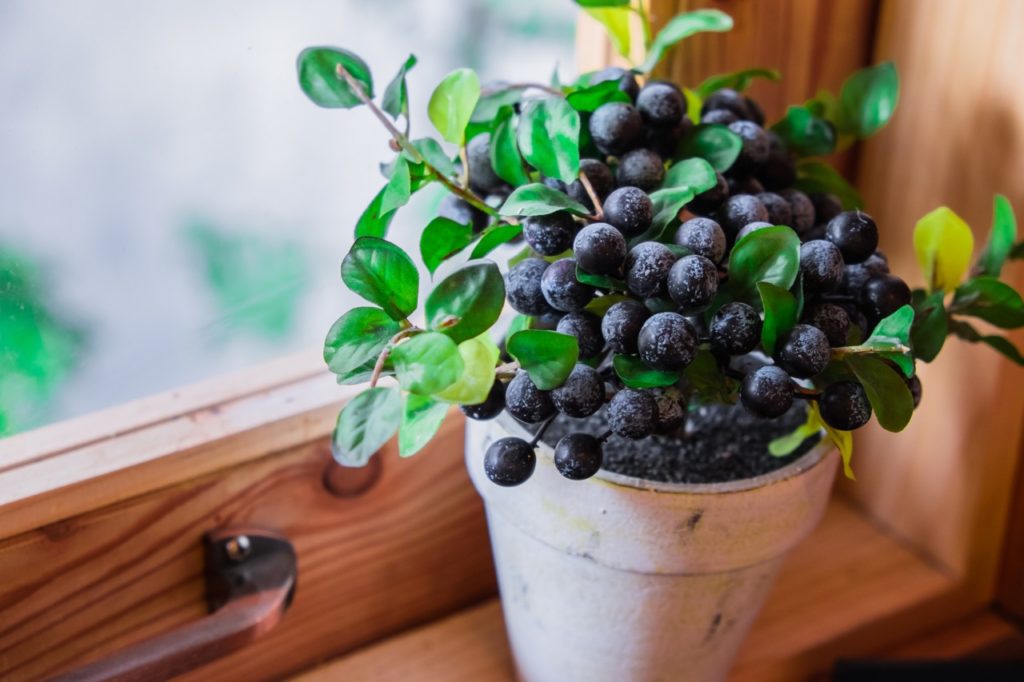
- COMMON NAME(S): blueberry ‘Top Hat’
- FOLIAGE: Green and bronze
- FLOWERS: White
- FLOWERING SEASON(S): Spring
- FRUIT: Blue
- TYPICAL SIZE: 0.5-1m in height, 0.5-1m spread
For a dwarf and compact blueberry that is ideal for containers or the patio, blueberry ‘Top Hat’ is perfect as it will only grow to 50cm tall and wide.
With white flowers in spring that produce flavoursome sky blue blueberries from July to August, it looks great coming into autumn as its foliage turns red.
Preferring full sun, ‘Top Hat’, if grown in a container, will need frequent watering, especially when fruits are forming, as pots tend to dry out more quickly.
9) V. corymbosum ‘Hortblue Petite’
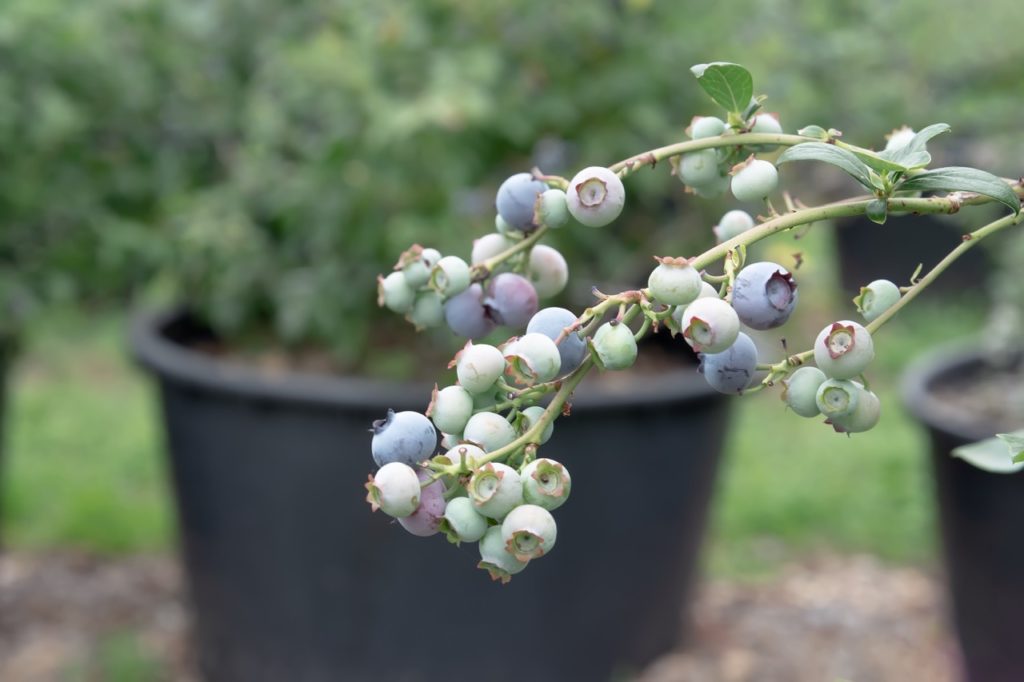
- COMMON NAME(S): blueberry ‘Hortblue petite’
- FOLIAGE: Green, red and blue
- FLOWERS: White and pink
- FLOWERING SEASON(S): Spring
- FRUIT: Blue
- TYPICAL SIZE: 0.5-1m in height, 0.5-1m spread
Blueberry ‘Hortblue Petite’ is rather special as it is a new cultivar that has been bred to crop twice in a growing season.
Fruiting in July and then September, it will produce delicious dark blue berries on a compact shrub that will only grow to an eventual size of 1m high with a 0.75m spread.
Like ‘Top Hat’, ‘Hortblue Petite’ is well suited to growing in a container, but can equally be grown in the ground in a sheltered and south-facing position.
As with other container-grown blueberries, it will benefit from a monthly liquid ericaceous feed throughout the growing period.
10) V. ‘Herbert’

- COMMON NAME(S): blueberry ‘Herbert’
- FOLIAGE: Green, red, orange and yellow
- FLOWERS: White
- FLOWERING SEASON(S): Spring
- FRUIT: Blue
- TYPICAL SIZE: 1.5-2.5m in height, 1.5-2.5m spread
Well known for its excellent flavour and large berries, blueberry ‘Herbert’ is a large shrub that will need space.
Reaching a size of 2.5m tall over time, it is a vigorous blueberry with an upright habit and produces fruit from late July to August.
Being deciduous, its green foliage turns a lovely bright red come autumn before dropping for the winter.
With a hardiness rating of H4, it is less hardy than some other blueberry cultivars, so care might be needed if the winter temperatures drop severely.
11) V. corymbosum ‘Aurora’

- COMMON NAME(S): blueberry ‘Aurora’
- FOLIAGE: Green, red, purple, orange and yellow
- FLOWERS: White
- FLOWERING SEASON(S): Spring
- FRUIT: Blue
- TYPICAL SIZE: 1.5-2.5m in height, 1.5-2.5m spread
For fruits to harvest later in the season, blueberry ‘Aurora’ produces large deep blue berries with a rich flavour from August into September.
A large cultivar with an upright habit, ‘Aurora’ can grow to 2.5m in height and spread when mature if given the right conditions and enough space to grow.
Providing intense autumnal foliage, blueberry ‘Aurora’ has great ornamental qualities before turning dormant for the colder months.
References
- 1The history of blueberries: From Native American staple to domesticated superfood. (2019, January 19). University of Illinois. Retrieved March 13, 2023, from https://extension.illinois.edu/blogs/garden-scoop/2019-01-19-history-blueberries-native-american-staple-domesticated-superfood
